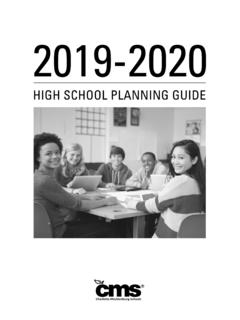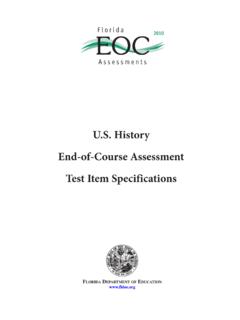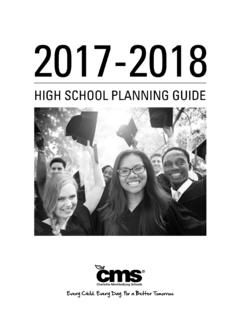Transcription of SOCIAL STUDIES - Georgia Standards
1 SOCIAL STUDIES . Georgia Standards of Excellence (GSE). Grade 6 Grade 8. SOCIAL STUDIES Georgia Standards of Excellence Table of Contents Sixth Grade .. 3. Seventh Grade .. 14. Eighth Grade .. 26. Georgia Department of Education June 9, 2016 Page 2 of 35. SOCIAL STUDIES Georgia Standards of Excellence Sixth Grade Latin America, the Caribbean and Canada, Europe, and Australia Sixth grade is the first year of a two-year World Area STUDIES course. Sixth grade students study Latin America, Canada, Europe, and Australia. The goal of this two-year course is to acquaint middle school students with the world in which they live. The geography domain includes both physical and human geography. The intent of the geography domain is for students to begin to grasp the importance geography plays in their everyday lives. The government/civics domain focuses on selected types of government found in the various areas so that students begin to understand the variety of governments in the world.
2 The economics domain builds on the K-5. economics Standards ; however, the focus shifts from the United States to how other countries answer the basic questions of economics. The history domain focuses on major events in each region during the twentieth and twenty-first centuries. Latin America and Canada Historical Understandings SS6H1 Explain conflict and change in Latin America. a. Describe the influence of African slavery on the development of the Americas. b. Describe the influence of the Spanish and the Portuguese on the language and religions of Latin America. c. Explain the impact of the Cuban Revolution and describe the current relationship between Cuba and the United States. d. Explain the impact of poverty, the war on drugs, and migration to the United States on Latin America. SS6H2 Describe Quebec's independence movement. Geographic Understandings SS6G1 Locate selected features of Latin America. a. Locate on a world and regional political-physical map: Amazon River, Amazon Rainforest, Caribbean Sea, Gulf of Mexico, Atlantic Ocean, Pacific Ocean, Panama Canal, Andes Mountains, Sierra Madre Mountains, and Atacama Desert.
3 B. Locate on a world and regional political-physical map the countries of Brazil, Chile, Colombia, Cuba, Mexico, and Panama. Georgia Department of Education June 9, 2016 Page 3 of 35. SOCIAL STUDIES Georgia Standards of Excellence SS6G2 Explain the impact of environmental issues in Latin America. a. Explain the causes and effects of air pollution in Mexico City, Mexico. b. Explain the environmental issue of destruction of the rain forest in Brazil. SS6G3 Explain the impact of location, climate, distribution of natural resources, and population distribution on Latin America. a. Explain how the location, climate, and distribution of natural resources impact trade and affect where people live in Mexico, Brazil, and Cuba. SS6G4 Locate selected features of Canada. a. Locate on a world and regional political-physical map: the St. Lawrence River, Hudson Bay, Atlantic Ocean, Pacific Ocean, the Great Lakes, Canadian Shield, and Rocky Mountains.
4 B. Locate on a world and regional political-physical map Canada and the province of Quebec. SS6G5 Explain the impact of location, climate, distribution of natural resources, and population distribution on Canada. a. Describe how Canada's location, climate, and natural resources impact trade and affect where people live. SS6G6 Explain the impact of environmental issues in Canada. a. Explain the causes and effects of pollution and acid rain in Canada to include the Great Lakes. b. Explain the causes and effects of the extraction of natural resources on the Canadian Shield ( , mining and logging). Government/Civic Understandings SS6CG1 Compare and contrast various forms of government. a. Explain citizen participation in autocratic, and democratic governments. [ the role of citizens in choosing the leaders of Mexico (presidential democracy), Cuba (autocratic), and Brazil (presidential democracy)]. b. Describe the two predominant forms of democratic governments: parliamentary and presidential.
5 SS6CG2 Explain citizen participation in the Canadian government. a. Explain the role of citizens in choosing the leader of Canada (parliamentary democracy). Georgia Department of Education June 9, 2016 Page 4 of 35. SOCIAL STUDIES Georgia Standards of Excellence Economic Understandings SS6E1 Analyze different economic systems. a. Compare how traditional, command, and market economies answer the economic questions of 1-what to produce, 2-how to produce, and 3-for whom to produce. b. Explain that countries have a mixed economic system located on a continuum between pure market and pure command. c. Compare and contrast the basic types of economic systems found in Mexico, Cuba, and Brazil. SS6E2 Give examples of how voluntary trade benefits buyers and sellers in Latin America. a. Explain how specialization encourages trade between countries. b. Compare and contrast different types of trade barriers, such as tariffs, quotas, and embargos.
6 C. Explain why international trade requires a system for exchanging currencies between nations. d. Explain the functions of the North American Free Trade Agreement (NAFTA). SS6E3 Describe factors that influence economic growth and examine their presence or absence in Brazil, Cuba, and Mexico. a. Evaluate how literacy rates affect the standard of living. b. Explain the relationship between investment in human capital (education and training) and gross domestic product (GDP per capita). c. Explain the relationship between investment in capital goods (factories, machinery, and technology) and gross domestic product (GDP per capita). d. Describe the role of natural resources in a country's economy. e. Describe the role of entrepreneurship. SS6E4 Analyze different economic systems. a. Compare how traditional, command, and market economies answer the economic questions of 1-what to produce, 2-how to produce, and 3-for whom to produce. b.
7 Explain that countries have a mixed economic system located on a continuum between pure market and pure command. c. Describe the economic system of Canada. Georgia Department of Education June 9, 2016 Page 5 of 35. SOCIAL STUDIES Georgia Standards of Excellence SS6E5 Give examples of how voluntary trade benefits buyers and sellers in Canada. a. Explain how specialization encourages trade between countries. b. Compare and contrast different types of trade barriers, such as tariffs, quotas, and embargoes. c. Explain why international trade requires a system for exchanging currencies between nations. d. Explain the functions of the North American Free Trade Agreement (NAFTA). SS6E6 Describe factors that influence economic growth and examine their presence or absence in Canada. a. Evaluate how literacy rates affect the standard of living. b. Explain the relationship between investment in human capital (education and training) and gross domestic product (GDP per capita).
8 C. Explain the relationship between investment in capital goods (factories, machinery, and technology) and gross domestic product (GDP per capita). d. Describe the role of natural resources in a country's economy. e. Describe the role of entrepreneurship. Europe Historical Understandings SS6H3 Explain conflict and change in Europe. a. Describe the aftermath of World War I: the rise of communism, the Treaty of Versailles, the rise of Nazism, and worldwide depression. b. Explain the rise of Nazism including preexisting prejudices, the use of propaganda, and events which resulted in the Holocaust. c. Explain how German reunification contributed to the collapse of the Soviet Union and led to the end of the Cold War. Geographic Understandings SS6G7 Locate selected features of Europe. a. Locate on a world and regional political-physical map: the Danube River, Rhine River, English Channel, Mediterranean Sea, European Plain, the Alps, Pyrenees, Ural Mountains, and Iberian Peninsula.
9 B. Locate on a world and regional political-physical map the countries of France, Germany, Italy, Russia, Spain, Ukraine, and United Kingdom. Georgia Department of Education June 9, 2016 Page 6 of 35. SOCIAL STUDIES Georgia Standards of Excellence SS6G8 Explain environmental issues in Europe. a. Explain the causes and effects of acid rain in Germany. b. Explain the causes and effects of air pollution in the United Kingdom. c. Explain the causes and effects of the nuclear disaster in Chernobyl, Ukraine. SS6G9 Explain the impact of location, climate, natural resources, and population distribution on Europe. a. Compare how the location, climate, and natural resources of Germany, the United Kingdom and Russia impact trade and affect where people live. SS6G10 Describe selected cultural characteristics of Europe. a. Describe the diversity of languages spoken within Europe. b. Identify the major religions in Europe: Judaism, Christianity, and Islam.
10 Government/Civic Understandings SS6CG3 Compare and contrast various forms of government. a. Explain citizen participation in autocratic and democratic governments. [ , role of citizens in choosing the leaders of the United Kingdom (parliamentary democracy), Germany (parliamentary democracy), and Russia (presidential democracy)]. b. Describe the two predominant forms of democratic governments: parliamentary and presidential. Economic Understandings SS6E7 Analyze different economic systems. a. Compare how traditional, command, and market economies answer the economic questions of 1-what to produce, 2-how to produce, and 3-for whom to produce. b. Explain that countries have a mixed economic system located on a continuum between pure market and pure command. c. Compare the basic types of economic systems found in the United Kingdom, Germany, and Russia. SS6E8 Analyze the benefits of and barriers to voluntary trade in Europe. a. Explain how specialization encourages trade between countries.
















